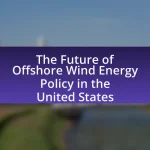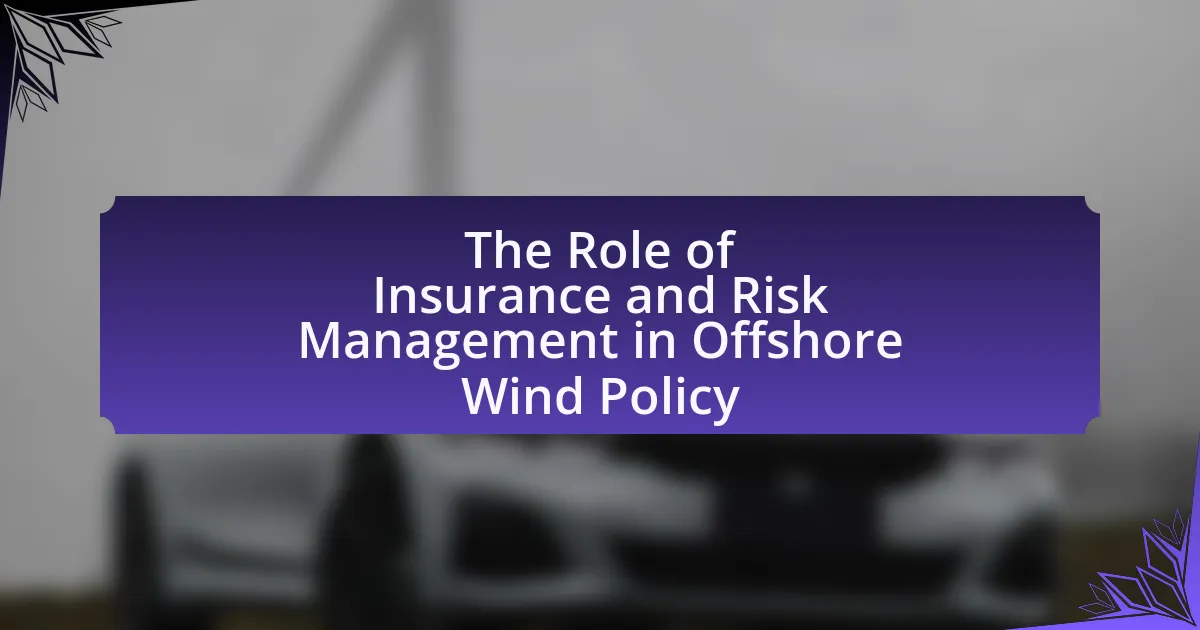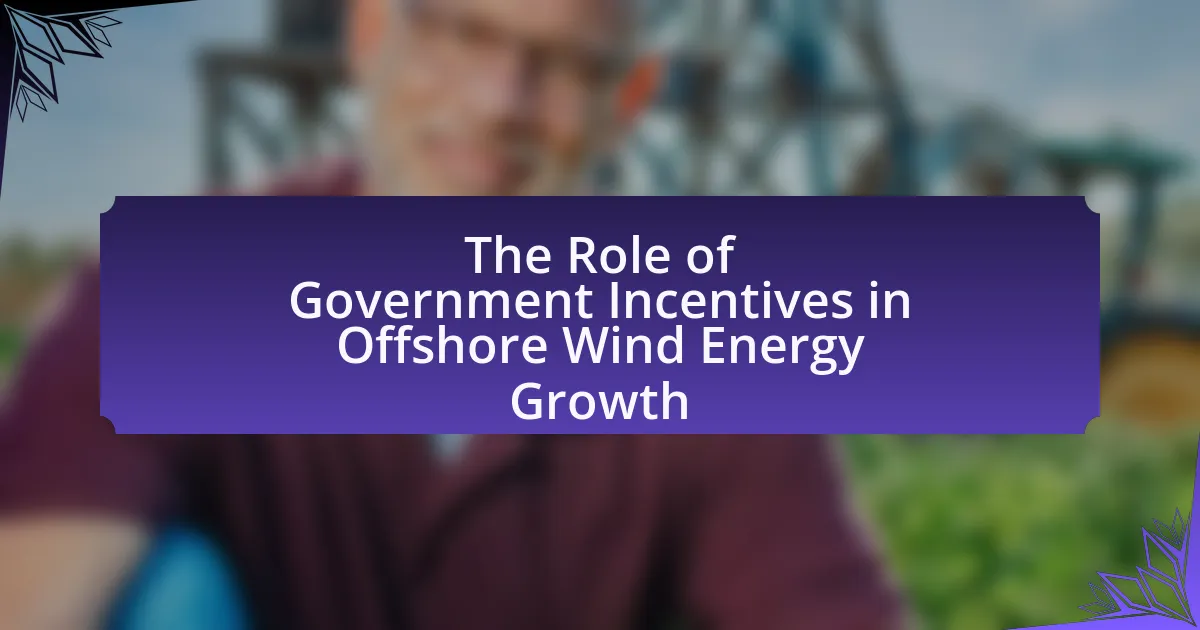Offshore wind energy is a renewable energy source that generates electricity from wind turbines situated in bodies of water, leveraging strong ocean winds. This article explores the concept of the Just Transition, which aims to ensure that the shift to renewable energy, including offshore wind, is equitable and inclusive for affected communities and workers. Key topics include the contribution of offshore wind to renewable energy goals, the technologies involved, the impact on local ecosystems, and the importance of policy considerations such as regulatory frameworks and stakeholder engagement. Additionally, the article addresses the challenges and opportunities presented by offshore wind energy, including job creation, economic growth, and the need for effective community involvement in shaping policies.
What is Offshore Wind Energy and the Just Transition?
Offshore wind energy refers to the generation of electricity from wind turbines located in bodies of water, typically on the continental shelf. This renewable energy source harnesses strong and consistent winds over the ocean, making it a viable alternative to fossil fuels. The Just Transition is a framework aimed at ensuring that the shift to renewable energy, including offshore wind, is equitable and inclusive, addressing the social and economic impacts on communities and workers affected by this transition. Evidence shows that transitioning to offshore wind energy can create jobs and stimulate economic growth while also reducing greenhouse gas emissions, aligning with global climate goals.
How does Offshore Wind Energy contribute to renewable energy goals?
Offshore wind energy significantly contributes to renewable energy goals by providing a substantial source of clean electricity. It harnesses strong and consistent winds over oceans, which allows for the generation of large amounts of energy, often exceeding that of onshore wind farms. For instance, according to the Global Wind Energy Council, offshore wind capacity reached over 35 gigawatts globally by the end of 2020, with projections estimating that it could supply up to 10% of the world’s electricity by 2040. This transition to offshore wind energy helps reduce greenhouse gas emissions, supports energy independence, and fosters economic growth through job creation in manufacturing, installation, and maintenance sectors.
What are the key technologies involved in Offshore Wind Energy?
The key technologies involved in offshore wind energy include wind turbine technology, floating platforms, and subsea cabling systems. Wind turbine technology, specifically designed for marine environments, features larger rotor diameters and advanced materials to withstand harsh conditions, enhancing energy capture and efficiency. Floating platforms allow turbines to be installed in deeper waters where traditional fixed-bottom turbines are not feasible, expanding the potential for offshore wind farms. Subsea cabling systems are crucial for transmitting the generated electricity from offshore turbines to onshore grids, ensuring efficient energy distribution. These technologies collectively contribute to the growth and viability of offshore wind energy as a sustainable energy source.
How does Offshore Wind Energy impact local ecosystems?
Offshore wind energy impacts local ecosystems primarily by altering marine habitats and affecting species interactions. The installation of wind turbines can lead to changes in seabed composition, which may disrupt benthic organisms and their habitats. Additionally, the presence of turbines can influence local fish populations by providing artificial reefs, potentially increasing biodiversity in some areas. Research indicates that while some species may benefit from these changes, others may experience negative effects due to habitat loss or altered food webs. For instance, a study published in “Environmental Impact Assessment Review” by G. M. W. van der Molen et al. (2020) highlights that the construction and operation of offshore wind farms can lead to both positive and negative ecological outcomes, emphasizing the need for careful site selection and monitoring to mitigate adverse impacts.
Why is the Just Transition important in the context of Offshore Wind Energy?
The Just Transition is important in the context of Offshore Wind Energy because it ensures that the shift towards renewable energy sources is equitable and inclusive for all stakeholders, particularly workers and communities affected by the transition. This approach addresses potential job losses in traditional energy sectors by promoting retraining and reskilling programs, thereby facilitating a smooth transition to new employment opportunities in the offshore wind industry. For instance, the International Renewable Energy Agency (IRENA) reported that the renewable energy sector could create 24 million jobs globally by 2030, highlighting the potential for economic growth and job creation through a Just Transition.
What principles define a Just Transition?
A Just Transition is defined by principles that ensure fairness and equity in the shift towards sustainable economies. These principles include social equity, which emphasizes the need to protect and empower affected workers and communities; environmental sustainability, focusing on minimizing ecological harm while promoting renewable energy; and economic viability, ensuring that new jobs and industries are created to replace those lost in traditional sectors. Additionally, participatory governance is crucial, as it involves stakeholders in decision-making processes to address their needs and concerns. These principles are supported by frameworks such as the International Labour Organization’s guidelines on Just Transition, which advocate for inclusive policies that balance economic growth with social justice.
How can Offshore Wind Energy support communities in transition?
Offshore wind energy can support communities in transition by providing sustainable job opportunities and fostering economic growth. The development of offshore wind farms creates a demand for skilled labor in construction, maintenance, and operation, which can help mitigate job losses in traditional industries such as coal or oil. For instance, a report by the U.S. Department of Energy indicates that the offshore wind sector could create over 77,000 jobs by 2030, significantly benefiting regions transitioning away from fossil fuels. Additionally, offshore wind projects can stimulate local economies through investments in infrastructure and services, enhancing community resilience and sustainability.
What are the Policy Considerations for Offshore Wind Energy?
Policy considerations for offshore wind energy include regulatory frameworks, environmental impact assessments, stakeholder engagement, and economic incentives. Regulatory frameworks must ensure compliance with safety and environmental standards while facilitating project development. Environmental impact assessments are crucial for understanding the potential effects on marine ecosystems and local communities. Stakeholder engagement involves collaboration with local populations, industries, and environmental groups to address concerns and gain support. Economic incentives, such as subsidies or tax credits, can promote investment and reduce costs, making offshore wind energy more competitive. These considerations are essential for the successful implementation and sustainability of offshore wind projects.
How do government policies influence Offshore Wind Energy development?
Government policies significantly influence Offshore Wind Energy development by establishing regulatory frameworks, providing financial incentives, and setting renewable energy targets. These policies create a conducive environment for investment and innovation in offshore wind projects. For instance, countries like the United Kingdom have implemented Contracts for Difference (CfD) schemes, which guarantee a fixed price for electricity generated from offshore wind, thereby reducing financial risk for developers. Additionally, the European Union’s Green Deal aims to increase offshore wind capacity to 300 GW by 2050, demonstrating a commitment to renewable energy that drives national policies and investments. Such frameworks not only facilitate project approvals but also enhance public and private sector collaboration, ultimately accelerating the growth of offshore wind energy.
What types of incentives are available for Offshore Wind Energy projects?
Offshore Wind Energy projects can access various incentives, including federal tax credits, state renewable energy certificates, and grants. The Investment Tax Credit (ITC) allows developers to deduct a significant percentage of the investment cost from their federal taxes, promoting capital investment in offshore wind. Additionally, many states offer Renewable Portfolio Standards (RPS) that require utilities to procure a certain percentage of energy from renewable sources, providing financial benefits to offshore wind projects. Grants from government programs, such as the Department of Energy’s Wind Energy Technologies Office, further support research, development, and deployment of offshore wind technologies. These incentives collectively aim to reduce the financial barriers associated with offshore wind energy development, facilitating a transition to cleaner energy sources.
How do regulations affect the deployment of Offshore Wind Energy?
Regulations significantly influence the deployment of offshore wind energy by establishing the legal framework and standards that projects must meet. These regulations encompass environmental assessments, permitting processes, and safety standards, which can either facilitate or hinder project development. For instance, the Bureau of Ocean Energy Management (BOEM) in the United States requires comprehensive environmental reviews before granting leases for offshore wind farms, ensuring that ecological impacts are considered. Additionally, regulations can dictate the timeline for project approval; lengthy permitting processes may delay deployment, while streamlined regulations can accelerate development. Overall, the regulatory landscape shapes the feasibility, cost, and speed of offshore wind energy projects, directly impacting their implementation and growth in the renewable energy sector.
What role do stakeholders play in shaping Offshore Wind Energy policies?
Stakeholders play a crucial role in shaping Offshore Wind Energy policies by influencing decision-making processes, advocating for specific interests, and providing essential feedback on proposed regulations. Their involvement includes government agencies, industry representatives, environmental organizations, and local communities, each contributing unique perspectives and expertise. For instance, government stakeholders establish regulatory frameworks that facilitate project development, while industry stakeholders advocate for technological advancements and investment. Environmental organizations often push for sustainable practices, ensuring ecological considerations are integrated into policy. Local communities provide insights on social impacts, fostering public acceptance and support for offshore wind projects. This collaborative engagement is vital for creating balanced policies that address economic, environmental, and social dimensions of offshore wind energy development.
How can community engagement improve policy outcomes?
Community engagement can improve policy outcomes by ensuring that the voices and needs of local stakeholders are incorporated into decision-making processes. Engaging communities allows policymakers to gather diverse perspectives, which can lead to more effective and tailored policies that address specific local challenges. For instance, studies have shown that when communities are involved in the planning of renewable energy projects, such as offshore wind farms, there is often greater public support and reduced opposition, resulting in smoother implementation and better alignment with community values. Research from the National Renewable Energy Laboratory indicates that community involvement can enhance project acceptance and lead to more sustainable outcomes, as local insights can inform better resource management and environmental considerations.
What are the challenges faced by policymakers in this sector?
Policymakers in the offshore wind energy sector face several challenges, including regulatory hurdles, financing issues, and stakeholder engagement. Regulatory hurdles arise from the need to navigate complex permitting processes and environmental assessments, which can delay project timelines. Financing issues stem from the high upfront capital costs associated with offshore wind projects, making it difficult to secure investment. Additionally, effective stakeholder engagement is crucial, as policymakers must balance the interests of local communities, environmental groups, and industry stakeholders to ensure successful project implementation. These challenges are compounded by the need for a skilled workforce and the integration of offshore wind into existing energy systems.
What are the Challenges and Opportunities in Offshore Wind Energy?
The challenges in offshore wind energy include high initial capital costs, complex regulatory frameworks, and technological limitations, while opportunities encompass significant potential for renewable energy generation, job creation, and advancements in technology. High initial capital costs can exceed billions of dollars for large-scale projects, making financing a critical hurdle. Complex regulatory frameworks often lead to lengthy permitting processes, which can delay project timelines. Technological limitations, such as the need for improved turbine efficiency and energy storage solutions, also pose challenges. Conversely, offshore wind energy has the potential to generate substantial amounts of clean energy, with estimates suggesting that offshore wind could provide up to 10% of global electricity by 2040. Additionally, the sector is poised to create hundreds of thousands of jobs in manufacturing, installation, and maintenance, contributing to economic growth. Advancements in technology, such as floating wind turbines, further enhance the feasibility of offshore wind projects in deeper waters, expanding the areas where energy can be harnessed.
What are the main challenges facing Offshore Wind Energy projects?
The main challenges facing Offshore Wind Energy projects include high capital costs, regulatory hurdles, and environmental concerns. High capital costs are significant, with estimates indicating that offshore wind projects can require investments exceeding $4 million per megawatt, making financing a critical issue. Regulatory hurdles arise from complex permitting processes, which can delay project timelines and increase costs; for instance, the average time to secure permits can take several years. Environmental concerns involve potential impacts on marine ecosystems and bird populations, leading to opposition from environmental groups and necessitating extensive environmental assessments. These challenges collectively hinder the growth and implementation of offshore wind energy initiatives.
How do supply chain issues impact Offshore Wind Energy development?
Supply chain issues significantly hinder Offshore Wind Energy development by causing delays in project timelines and increasing costs. These disruptions can arise from shortages of critical components, such as turbines and cables, which are essential for constructing and operating wind farms. For instance, the Global Wind Energy Council reported that supply chain bottlenecks contributed to a 20% increase in project costs in 2021, impacting the overall feasibility and competitiveness of offshore wind projects. Additionally, logistical challenges in transporting large components to offshore sites can further exacerbate delays, ultimately affecting energy production timelines and investment returns.
What are the financial risks associated with Offshore Wind Energy investments?
The financial risks associated with Offshore Wind Energy investments include high capital costs, regulatory uncertainties, and market volatility. High capital costs arise from the significant investment required for infrastructure, which can exceed billions of dollars for large projects. Regulatory uncertainties stem from changing policies and permitting processes that can delay projects and increase costs; for instance, the U.S. offshore wind sector has faced evolving regulations that impact timelines and budgets. Market volatility affects the price of electricity generated, influenced by factors such as competition from other energy sources and fluctuations in demand. According to a report by the International Renewable Energy Agency, the levelized cost of electricity for offshore wind projects can vary significantly based on these factors, highlighting the inherent financial risks involved.
What opportunities does Offshore Wind Energy present for economic growth?
Offshore wind energy presents significant opportunities for economic growth through job creation, investment in infrastructure, and technological innovation. The sector is projected to create over 1.3 million jobs globally by 2030, according to the International Renewable Energy Agency. Additionally, investments in offshore wind projects can stimulate local economies, with the U.S. offshore wind market expected to reach $70 billion by 2030, as reported by the U.S. Department of Energy. Furthermore, advancements in turbine technology and energy storage solutions drive innovation, enhancing efficiency and reducing costs, which can lead to further economic benefits.
How can Offshore Wind Energy create jobs in coastal communities?
Offshore wind energy can create jobs in coastal communities by generating employment opportunities in manufacturing, installation, maintenance, and support services related to wind turbines. The development of offshore wind farms requires a skilled workforce for constructing turbine components, transporting them to installation sites, and ongoing maintenance, which can significantly boost local economies. For instance, a report by the U.S. Department of Energy indicates that the offshore wind sector could create over 77,000 jobs by 2030, particularly benefiting coastal regions with access to wind resources and port facilities. This job creation not only supports direct employment but also stimulates ancillary industries, such as logistics and supply chain management, further enhancing economic growth in these communities.
What are the potential benefits for local economies from Offshore Wind Energy?
Offshore wind energy can significantly benefit local economies by creating jobs, stimulating investment, and enhancing energy independence. The development and maintenance of offshore wind farms require a skilled workforce, leading to job creation in manufacturing, installation, and ongoing operations. For instance, a report by the U.S. Department of Energy indicates that the offshore wind sector could support over 77,000 jobs by 2030. Additionally, local businesses can thrive through increased demand for services and materials needed for wind farm construction and maintenance, fostering economic growth in the region. Furthermore, offshore wind energy contributes to energy independence, reducing reliance on imported fossil fuels and stabilizing local energy prices, which can further enhance economic resilience.
What best practices can be adopted for a successful Offshore Wind Energy transition?
To achieve a successful Offshore Wind Energy transition, best practices include comprehensive stakeholder engagement, robust regulatory frameworks, and investment in workforce development. Comprehensive stakeholder engagement ensures that local communities, industry players, and government entities collaborate effectively, fostering public support and minimizing opposition. Robust regulatory frameworks provide clear guidelines and incentives for developers, which can accelerate project approvals and enhance investment security. Investment in workforce development is crucial, as it prepares the local labor force for the specialized jobs created by the offshore wind sector, thereby promoting economic growth and sustainability. These practices are supported by successful case studies from countries like Denmark and Germany, where stakeholder collaboration and regulatory clarity have led to significant advancements in offshore wind capacity.




